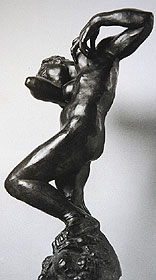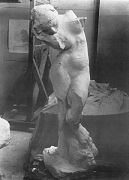Rodin Works: meditation, The inner voice |
|
For the incorporation of 'Meditation' in the 'Monument to Victor Hugo', Rodin cut off the arms, one knee and the outer part of the right leg. "The arms are missing. In this case Rodin felt them to
be too easy a solution for his task, as if they did not belong to a body
which wanted to wrap itself up, without any outside help. Rodin's statues
without arms lack nothing essential to them. In front of them, we feel we
are in front of a completed whole which admits no complement." [R. M. Rilke, Auguste Rodin, 1928] This fragment was enlarged, shown in Paris in 1896 and cast in bronze during his lifetime. Rodin always preferred this fragmentary version of his 'Inner Voice': "The study of nature is complete here and I have made every effort to render art as whole as possible. I consider this plaster to be one of my best finished works, the most perfect (sic)." Many other fragments have followed in Rodin's artistic evolution. In 1910, he explained to Muriel Ciolkowska: "Recently I have taken to isolating limbs, the torso. Why am I blamed for it? Why is it allowed the head and not portions of the body? Every part of the human figure is expressive. And is not an artist always isolating, since in Nature nothing is isolated? When my works do not consist of the complete body (..), people call it unfinished. What do they mean? Michelangelo´s finest works are precisely those which are called 'unfinished'. Works which are called finished are those who are clean - that is all." [Quoted by Grunfeld, Rodin - A Biography, p. 573] |

